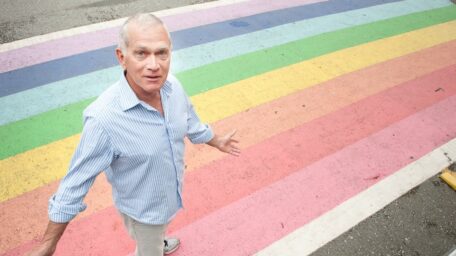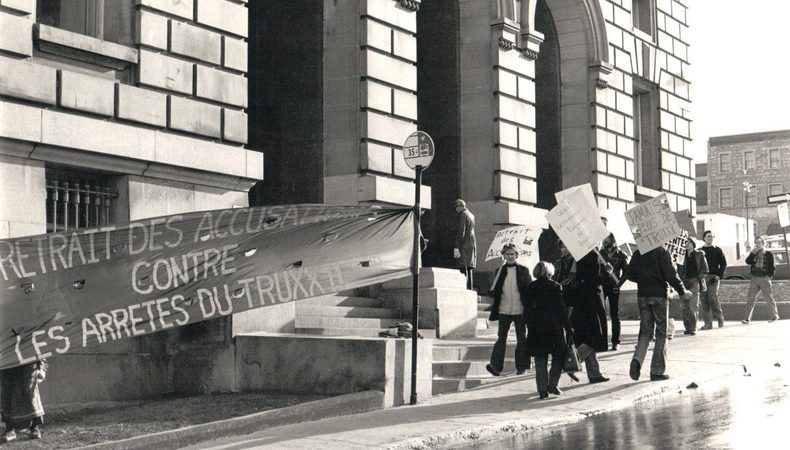Harry Sutherland

Documentarist, producer. A rare example of a truly pan-Canadian documentary film and video maker, Sutherland worked in social action documentary in Halifax, Montreal, Nunavut, Toronto and Vancouver. His queer activist work began in the mid-seventies in Montreal under the indirect rubric of the NFB’s community activist program Challenge for Change, and the passion for community interaction has remained.
This passion led to the first gay liberation activist documentary in Canada, Truxx (1978), a short manifesto of collective resistance to police oppression in the wake of the historic 1977 raid on the Montreal gay bar Truxx. In 1976 the City of Montréal launched a pre-Olympic cleanup of gays and prostitutes, a new wave of persecution that shocked the gay community out of its complacency, both francophone and anglophone, and whole-scale organizing started up again, energized by the simple exigency of self-defense. The police responded in October 1977 by swooping with machine-guns into the Stanley Street bar Truxx, and made the largest mass arrest since the October Crisis. 146 men were forcibly given VD tests (a Q-tip punitively inserted into the urethra), crammed incommunicado all night into tiny cells with standing room only, and charged the next day under the familiar vague and discriminatory bawdy-house and gross indecency laws. That night, 3000 protesters blocked the streets of what was then the West End Peel-Stanley gay ghetto for several hours, and as the Journal de Montréal headline screamed, “Les Homos et la police: c’est la guerre!” No more than 300 demonstrators had ever shown up for a gay lib demo before, and two months later an embarrassed and still idealistic PQ government (only one year in office) passed Loi 88, the first human rights legislation protecting lesbians and gays anywhere in the world (Norway joined Quebec in 1981). The charges hung over the heads of the accused for several years thereafter before finally being dropped.
Truxx appeared the year following the events and narrated them simply and directly. Made on a shoestring and transferred from then rare video to 16mm, the film aimed at bolstering organizing in the gay community around the issue. Sutherland used still photos, a voice-over, and interviews with two victims and two activists, concluded with footage of subsequent demonstrations. The editing and pace are rough, and the dubbing is cheap—two interviews are in English, two in French, but only the English version was ever released because of lack of funds. The effect of the two interviews with victims, one an anglophone musician and the other a francophone bicycle repairer (a division of labour that did not always appeal to francophone spectators), was stunning for tearful audiences who saw their communal experience and anger on the screen for the first time. The film holds up well a quarter century later—a reminder for many that little has changed in police-community relations in Montreal as elsewhere—but has not been available for many years. A spinoff of Truxx, aimed at the high school market, was the three directors’ documentary short Paul/David, which caused the nineteen-year-old TBP film critic John Greyson some consternation for falling short of that tough audience’s high standards (#58, Nov. 1979).
Relocated to Toronto, Sutherland and his collaborators Gordon Keith and Jack Lemmon continued in the same vein, producing the pioneering epic Track Two (1982), about community defiance of the police in reaction to the 1981 bathhouse raids. The documentary recounts queer Toronto’s coming of age in that cold winter after the historic 5 February swoop by Toronto police on four local bathhouses and their violation of 286 gay bodies and the rights of an entire community. Inaugurated as a document about George Hislop’s doomed 1980 aldermanic campaign, the team suddenly found themselves with a much larger project on their hands. Trained in fast response, they caught everything on film: the quiet testimony of one victim who says, credibly, that he now understands how his parents felt at Auschwitz; the huge and defiant rallies and nighttime street demonstrations; the plainclothes agents provocateurs who actually held the banner out in front! (The raid itself was re-enacted on location in the Richmond Street Spa.) While a few mainstream media homophobes saw nothing but a “boring documentary that’s little more than a series of talking heads” (Montreal Gazette, 30 October 1982), most other viewers were caught up in the electricity of history in the making. Jay Scott, the Globe and Mail’s not-yet-out reviewer called it “admirable comprehensive consideration of the late seventies and early eighties, years during which Toronto’s homosexual community evidently underwent unprecedented radicalization (1 July 1982).” But Michael Lynch in TBP best captured the hushed but euphoric impact the film had on Canadian and especially Toronto queer audiences:
As a historical document, it confirms who we are and what we’ve been through. I heard a cry from deep within myself: yes, this is and was my life, our lives. I felt gratitude to the film for returning what time takes away; our history our heart…. the most intelligent gay thesis film I know… An instrument which not only documents a community creating itself but, itself, further creates that community…. it creates a fresh universe by adding nothing but itself (1982).
Two decades later the film holds up fairly well as a vivid period piece, still capable of fomenting strong responses, although some spectators born around the time of the raids themselves find the low-budget celluloid vérité style somewhat roughhewn and the fervent plaid-shirted talking-head activists creatures from another planet–as indeed they are.
A decade after this historic work, Memo from Church Street (1993) covered similar territory, taking stock of the evolved and more confident community, but met with lukewarm response in the era of burgeoning queer media and film festivals. In more recent years, based in Vancouver, Sutherland concentrated on producing rather than directing, contributing to key documentaries from David Adkin’s We’re Funny That Way (1998) to Aerlyn Weissman’s Little Sister’s vs Big Brother (2002).
Contributors to this biography: David Adkin, Aerlyn Weissman




